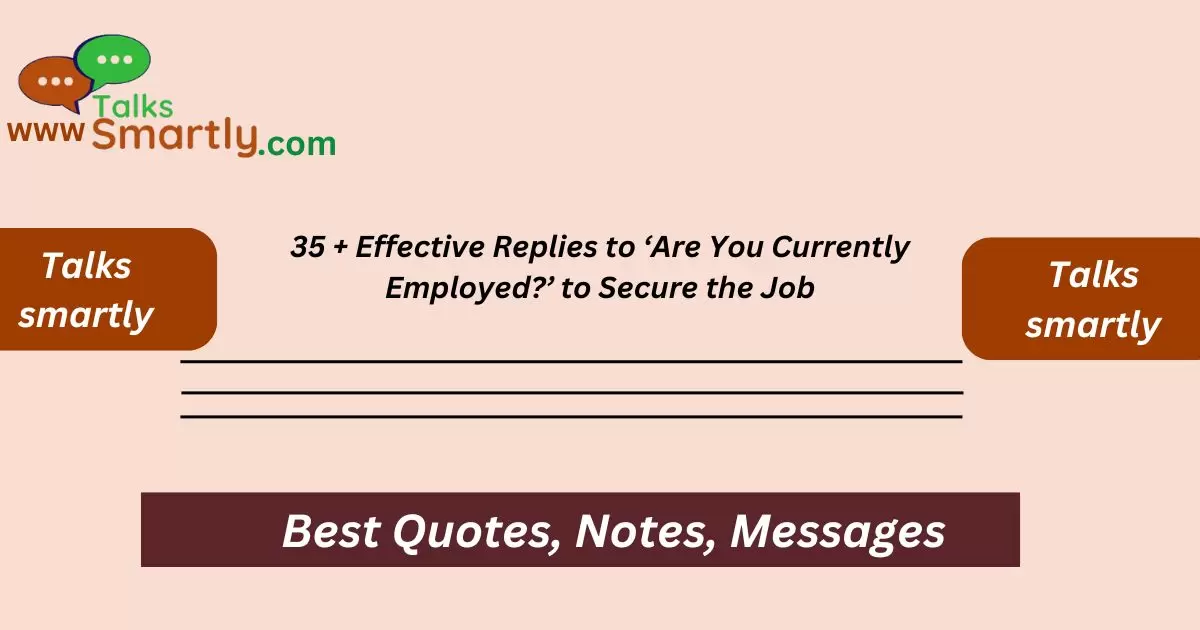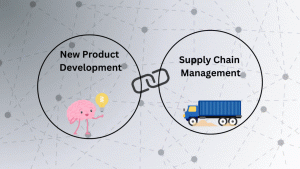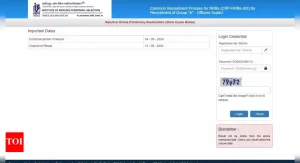Introduction
“Learn powerful responses to ‘Are You Currently Employed?’ to enhance your job prospects.”
Looking for effective ways to respond when asked, “Are you currently employed?” in a job interview? This article offers practical strategies and phrases to help you confidently handle this common interview question. Whether you’re actively employed or seeking new opportunities, knowing how to respond can make a significant difference in navigating your job search process smoothly.
Discover proven responses that showcase your skills and experience, tailored to different employment situations. From emphasizing your professional achievements to highlighting your career goals, each response is crafted to impress potential employers and increase your chances of securing the job.
Explore over 35 effective replies designed to showcase your suitability for the role, regardless of your current employment status. Each response is backed by strategic insights aimed at helping you stand out in interviews and make a positive impact on employers.
Smart Ways to Answer ‘Are You Currently Employed’
1. Highlighting Freelance Work
“I’m currently engaged in several freelance projects that allow me to refine my skills and manage my schedule effectively.”
2. Emphasising Professional Development
“I’m taking this time to focus on professional development by attending courses and workshops to enhance my qualifications.”
3. Mentioning Consulting Roles
“I’m currently working as a consultant, which has given me valuable experience in diverse industries and flexible work opportunities.”
4. Pointing Out Volunteer Work
“I’ve been actively volunteering with [Organization Name], where I’m applying my skills to make a meaningful impact.”
5. Indicating Contract Work
“I’m currently on a short-term contract with [Company Name], which is a great fit for my expertise and schedule.”
!["I’m currently on a short-term contract with [Company Name], which is a great fit for my expertise and schedule."](https://talkssmartly.com/wp-content/uploads/2024/07/im-currently-on-a-short-term-contract-with-company-name-which-is-a-great-fit-for-my-expertise-and-schedule.webp)
6. Discussing Part-Time Work
“I’m working part-time with [Company Name], which allows me to maintain a balance while seeking full-time opportunities.”
7. Highlighting Side Projects
“I’ve been dedicating time to personal side projects that align with my career goals and help me stay productive.”
8. Preparing for a Career Shift
“I’m in the process of transitioning to a new field, so I’m dedicating time to gaining relevant skills and knowledge.”
9. Focusing on Networking
“I’ve been focusing on expanding my professional network, attending industry events, and building relationships that support my career growth.”
10. Engaging in Research
“I’m currently involved in a research project related to my field, which is both challenging and rewarding.”
11. Personal Development Focus
“I’m taking this opportunity to focus on personal development, including improving my skills and exploring new career paths.”
12. Exploring New Opportunities
“I’m exploring various opportunities that align with my career goals and values, ensuring the best fit for my next role.”
13. Working on Certifications
“I’m currently working towards obtaining [specific certification], which will significantly enhance my qualifications for future roles.”
14. Staying Updated with Industry Trends
“I’m dedicating time to staying updated with the latest industry trends and technologies to remain competitive in the job market.”
15. Balancing Family Commitments
“I’ve been balancing family commitments with professional development activities, ensuring I’m ready for the right opportunity.”
16. Building a Personal Brand
“I’m actively building my personal brand through blogging and social media to establish myself as a thought leader in my field.”
17. Engaging in Temporary Work
“I’m involved in temporary work assignments that provide valuable experience while I search for a long-term position.”
18. Mentoring Others
“I’ve been mentoring young professionals, which is a fulfilling way to share my knowledge and experience while staying engaged in my field.”
19. Focusing on Health and Well-being
“I’ve taken some time to focus on my health and well-being, ensuring I’m at my best for my next professional challenge.”
20. Pursuing Entrepreneurial Ventures
“I’m pursuing entrepreneurial ventures that allow me to apply my skills creatively and explore new business opportunities.”
21. Enhancing Technical Skills
“I’m currently enhancing my technical skills through various online platforms, which keeps me updated and sharp in my field.”
22. Collaborating on Open Source Projects
“I’m collaborating on open-source projects, contributing to the community while honing my skills in a real-world context.”
23. Learning a New Language

“I’m learning a new language to broaden my cultural understanding and enhance my communication skills for global opportunities.”
24. Developing a Startup
“I’m working on developing a startup idea, which has provided me with valuable insights into business management and innovation.”
25. Engaging in Artistic Pursuits
“I’ve been engaging in artistic pursuits that stimulate my creativity and offer a balanced approach to my professional life.”
Text Etiquette : How to Craft the Perfect Reply to a Missed Call
26. Attending Industry Conferences
“I’ve been attending industry conferences to stay abreast of the latest trends and network with professionals in my field.”
27. Publishing Research Papers
“I’m in the process of publishing research papers on topics related to my expertise, contributing to the academic community.”
28. Taking a Sabbatical for Skill Enhancement
“I’m on a sabbatical to focus on skill enhancement and personal growth, ensuring I’m well-prepared for my next career move.”
29. Participating in Online Communities
“I’m actively participating in online professional communities, where I share insights and learn from industry experts.”
30. Engaging in Remote Work
“I’m currently engaged in remote work assignments, which offer flexibility and the opportunity to work with diverse teams.”
31. Collaborating with Nonprofits
“I’m collaborating with nonprofit organizations, applying my skills to support their missions and gain new perspectives.”
32. Writing and Publishing Articles
“I’m writing and publishing articles on industry-specific topics, establishing my voice and expertise in my field.”
33. Preparing for Certification Exams
“I’m preparing for certification exams, which will validate my skills and open new opportunities for advancement.”
34. Engaging in Coaching or Mentoring
“I’m engaged in coaching or mentoring roles, helping others develop their careers while staying active in my field.”
35. Pursuing an Advanced Degree
“I’m pursuing an advanced degree, which will enhance my qualifications and provide new insights into my profession.”
36. Conducting Market Research
“I’m conducting market research to stay informed about industry trends and identify potential opportunities for growth.”
37. Volunteering in Professional Organizations
“I’m volunteering in professional organizations, contributing to their initiatives and expanding my network.”
38. Building an Online Portfolio
“I’m building an online portfolio to showcase my work and skills, making it easier for potential employers to see my capabilities.”
39. Teaching or Training Others
“I’m involved in teaching or training programs, sharing my knowledge and gaining new insights from different perspectives.”
40. Working on Innovative Projects
“I’m working on innovative projects that push the boundaries of my creativity and technical skills.”
Direct Answers: When Less is More
Explanation
When asked about your current employment status, sometimes a straightforward answer is the best approach. Providing a concise response can prevent over-explanation and allow you to steer the conversation in a more positive direction.
1. Be Clear and Concise
A direct answer like “I’m currently not employed” can be effective. Follow up with a positive statement about what you’re looking for or working on.
2. Focus on the Present
Keep your answer focused on what you’re doing now or what you’re looking to achieve, rather than delving into past details.
3. Avoid Over-Explanation
Offering too much information can lead to unnecessary questions and scrutiny. Stick to the basics unless prompted for more.
4. Maintain Confidence
A confident, straightforward answer can demonstrate self-assurance and control over your career path.
5. Be Honest
Honesty builds trust. Even a simple “I’m between jobs at the moment” can be effective if delivered with confidence and followed by your plans for the future.
Honesty Matters: Finding the Balance
Explanation
While honesty is crucial, it’s important to balance transparency with tact. Providing too much detail can sometimes work against you, so it’s essential to be strategic in your responses.
1. Be Transparent
Acknowledge your current status honestly without hiding or fabricating information.
2. Keep It Positive
Frame your situation positively. For example, “I left my last role to seek new opportunities that align with my career goals.”
3. Focus on the Future
Shift the conversation to what you are looking to achieve next and how the current opportunity fits into your plans.
4. Be Prepared for Follow-ups
Anticipate and prepare for follow-up questions to maintain control over the conversation.
5. Use Professional Language
Maintain a professional tone and avoid negative language when discussing past employment.
Scenario 1: You Left a Job Due to a Negative Environment
Explanation
Leaving a job due to a negative environment is a sensitive topic. It’s essential to address this without bad-mouthing your previous employer.
1. Keep It Neutral
“I decided to leave my previous role because I was seeking a more positive and collaborative work environment.”
2. Focus on Positives
Emphasize your desire for growth and a supportive work culture rather than the negatives of the past job.
3. Highlight Your Goals
Explain how the move aligns with your long-term career goals and values.
4. Be Brief
Avoid going into too much detail about the negative environment to keep the conversation forward-focused.
5. Be Honest but Tactful
Honesty is key, but present it in a way that does not reflect poorly on you or your previous employer.
Scenario 2: You Were Fired
Explanation
Being fired can be a challenging topic to discuss, but it’s important to approach it with honesty and a focus on what you’ve learned and how you’ve grown since then.
1. Acknowledge the Situation
“I was let go from my previous position, which was a challenging experience.”
2. Focus on Growth
Emphasize what you learned from the experience and how it has prepared you for future roles.
3. Highlight Accountability
Show that you understand the reasons for your dismissal and what steps you’ve taken to improve.
4. Be Brief and Positive
Keep the explanation short and positive, focusing on your readiness for new opportunities.
5. Prepare for Follow-ups
Be ready to answer follow-up questions about the situation with honesty and professionalism.
Scenario 3: You Have a Significant Employment Gap
Explanation
Addressing an employment gap requires a focus on the productive activities you engaged in during that time.
1. Explain the Gap
Briefly explain the reason for the gap, whether it was due to personal reasons, education, or other valid activities.
2. Highlight Productivity
Emphasize the productive activities you were involved in during the gap, such as volunteering, freelancing, or skill development.
3. Show Relevance
Connect those activities to the skills and experiences relevant to the job you’re applying for.
4. Keep It Positive
Maintain a positive tone when discussing the gap and focus on how it has prepared you for the current opportunity.
5. Be Honest
Provide a truthful explanation without over-justifying the gap.
Anticipate Follow-up Questions
Explanation
Preparing for potential follow-up questions ensures you stay composed and can address any concerns effectively.
1. Identify Common Questions
Consider common follow-up questions you might face based on your situation.
2. Prepare Your Responses
Craft thoughtful and concise responses to those questions.
3. Practice Delivery
Practice your answers to ensure they come across confidently and naturally.
4. Stay Positive
Maintain a positive tone in all your responses to keep the conversation forward-focused.
5. Be Ready to Pivot
Be prepared to pivot the conversation back to your strengths and future goals.
Example:
Explanation
Providing examples can help illustrate how to handle these situations effectively.
Scenario 1: Leaving Due to a Negative Environment
“After careful consideration, I decided to leave my previous job because I was seeking a more supportive and positive work environment. During my time off, I took several courses to enhance my skills and am now looking for a role where I can contribute and grow.”
Scenario 2: Being Fired
“Being let go from my last job was a challenging experience. It gave me an opportunity to reflect on my career and focus on my professional development. I’ve since taken steps to improve my skills and am eager to bring my newfound knowledge and experience to a new role.”
Another Example:
Explanation
A second example can offer additional clarity on how to handle these topics.
Scenario 3: Employment Gap
“I took a career break to focus on personal development and family commitments. During this time, I stayed active in my field through freelance work and online courses. I’m now ready to bring my updated skills and fresh perspective to a new, full-time role.”
Finally,
Explanation
Summarising the key points ensures that you end on a strong note.
1. Stay Positive
Always frame your situation in a positive light.
2. Be Honest
Honesty builds trust, but balance it with a focus on your growth and future goals.
3. Keep It Concise
Provide clear and concise answers to avoid over-explanation.
4. Focus on the Future
Highlight what you’ve learned and how it prepares you for future opportunities.
5. Prepare and Practice
Preparation is key to handling tough questions with confidence and professionalism.
Conclusion
Navigating questions about your current employment status can be challenging, but with the right approach, you can turn these inquiries into opportunities to showcase your growth, resilience, and future aspirations.
By providing direct and concise answers, balancing honesty with positivity, and preparing for potential follow-up questions, you can maintain control of the conversation and leave a positive impression.
Whether you’re discussing a negative work environment, a dismissal, or an employment gap, focus on the lessons learned and how they have prepared you for new opportunities.
With careful preparation and practice, you can confidently address any employment status questions and highlight your readiness for the next step in your career journey.












